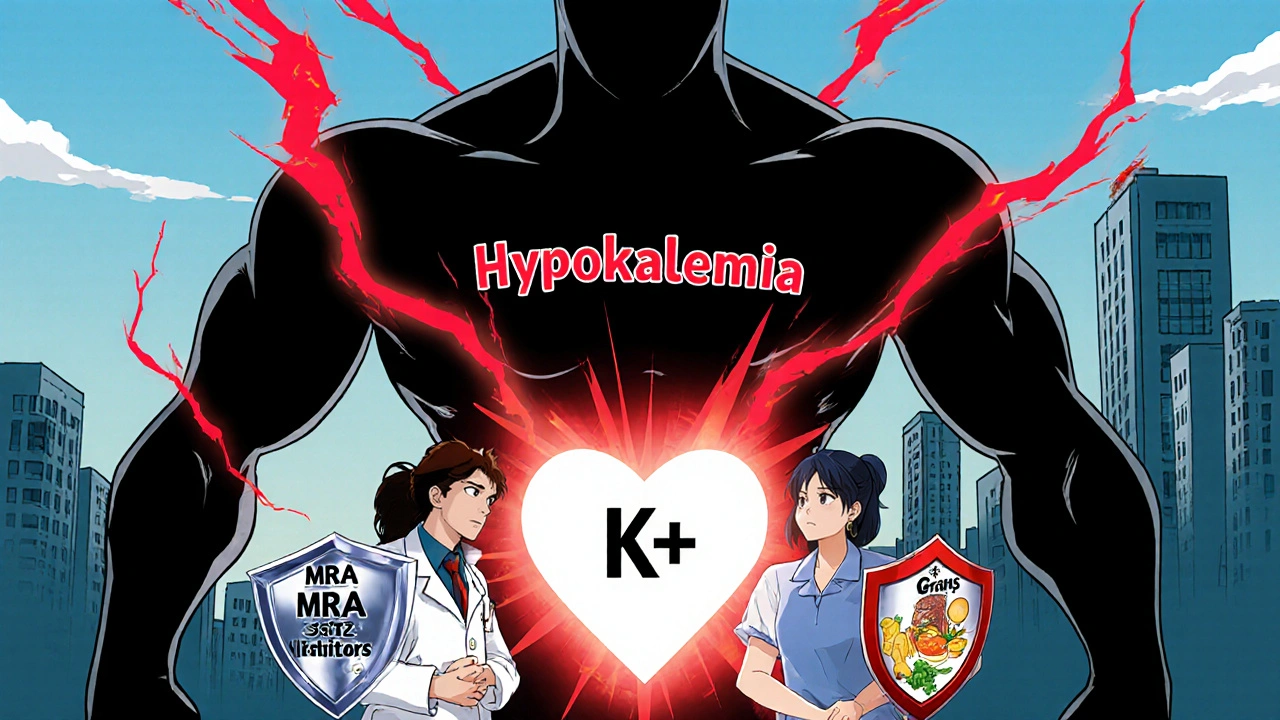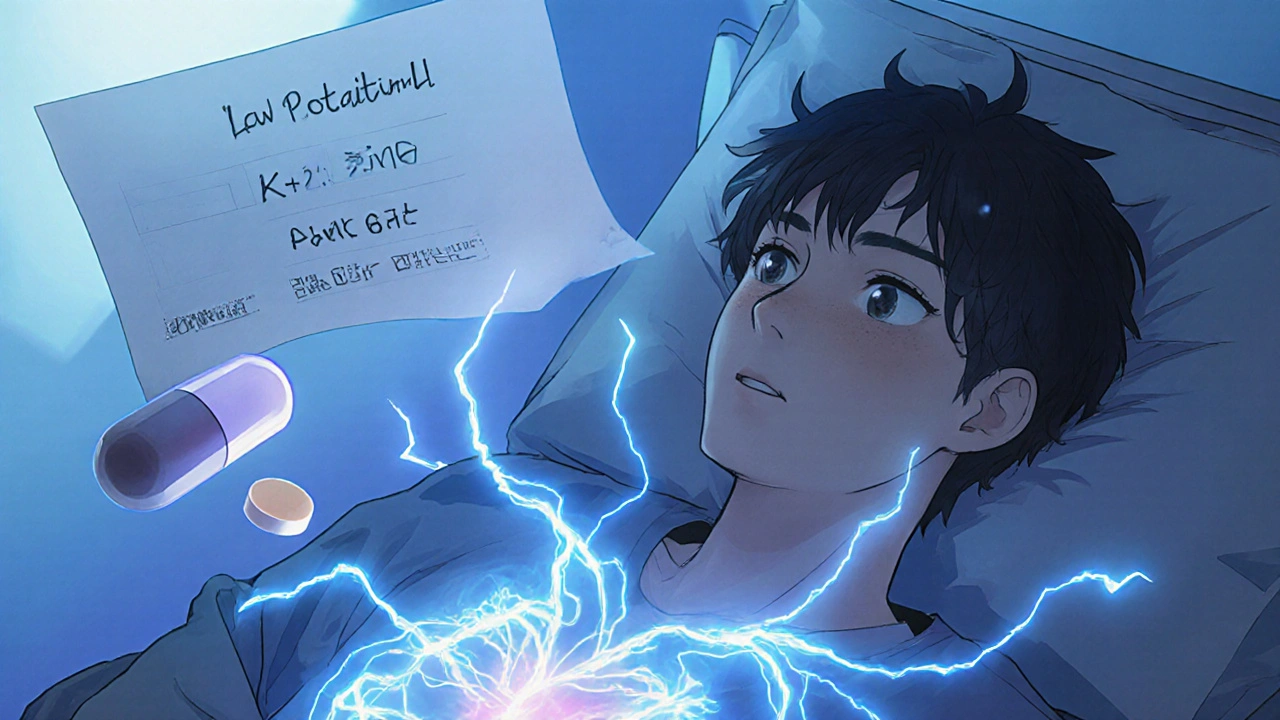Hypokalemia Management Calculator
Patient Assessment
Why Diuretics Cause Low Potassium in Heart Failure
Diuretics are one of the most common treatments for heart failure. They help remove extra fluid from the body, easing swelling, shortness of breath, and fatigue. But there’s a hidden cost: hypokalemia-low potassium in the blood. This isn’t just a lab result. It’s a real risk that can trigger dangerous heart rhythms, especially in people with damaged hearts.
Loop diuretics like furosemide, bumetanide, and torsemide are the go-to drugs for fluid overload. They work by blocking salt reabsorption in the kidneys, which pulls water out too. But here’s the catch: when salt leaves, potassium follows. The kidneys end up dumping too much potassium into the urine. About 20-30% of heart failure patients on these drugs develop potassium levels below 3.5 mmol/L. That’s not rare-it’s expected.
What makes this worse? Higher doses. People who need more diuretics because their heart failure is advanced are at the highest risk. So are those taking other potassium-wasting drugs like thiazides or laxatives. Even dietary salt restriction, which is often recommended, can backfire. Less salt means the body releases more aldosterone, a hormone that tells the kidneys to dump even more potassium.
Why Low Potassium Is Dangerous in Heart Failure
Potassium isn’t just another mineral. It’s the electrical conductor of your heart. When levels drop below 3.5 mmol/L, the heart’s rhythm becomes unstable. Studies show that heart failure patients with potassium under 3.5 mmol/L have a 1.5 to 2 times higher risk of dying. That’s not a small bump-it’s a cliff.
People with structural heart damage-like those who’ve had a heart attack or have weakened heart muscle-are especially vulnerable. Their hearts are already struggling. Low potassium adds another layer of stress. It can lead to ventricular tachycardia, torsades de pointes, or sudden cardiac arrest. These aren’t theoretical risks. They show up in emergency rooms and morgues.
And here’s something counterintuitive: when potassium drops, it’s often a sign that the heart failure isn’t being managed well overall. It’s not always the diuretic’s fault. It’s a red flag that the whole treatment plan needs a second look.
How to Fix Low Potassium-Step by Step
Fixing hypokalemia isn’t about just popping a potassium pill. It’s about balancing three things: replacing lost potassium, stopping further loss, and adjusting the bigger treatment picture.
Step 1: Start with potassium supplements
If potassium is between 3.0 and 3.5 mmol/L, oral potassium chloride is usually enough. Give 20-40 mmol per day, split into two doses to avoid stomach upset. Don’t use potassium chloride tablets all at once-they can burn the gut. Liquid forms or extended-release tablets are gentler.
Step 2: Add a potassium-sparing diuretic
This is the game-changer. Mineralocorticoid receptor antagonists (MRAs) like spironolactone (12.5-25 mg daily) or eplerenone (25 mg daily) block the hormone that makes kidneys dump potassium. These drugs don’t just fix potassium-they save lives. The RALES trial showed spironolactone cut death risk by 30% in severe heart failure patients. That’s why guidelines now recommend them for almost all heart failure patients with reduced ejection fraction, even if potassium is normal.
Step 3: Check for hidden causes
Don’t assume the diuretic is the only culprit. Look at meds: are they taking corticosteroids? Laxatives? Are they vomiting or having diarrhea? Are they skipping meals? Poor diet, especially low in fruits and vegetables, makes everything worse. A simple conversation about food can reveal more than a blood test.

When to Use IV Potassium-and When Not To
If potassium drops below 3.0 mmol/L, or if the patient has symptoms like muscle weakness, palpitations, or ECG changes (flattened T waves, U waves), IV replacement is needed. But this isn’t a quick fix. It’s a controlled process.
Give no more than 10-20 mmol per hour, always with continuous heart monitoring. Never push potassium fast. A rapid infusion can stop the heart. Hospitals have strict rules for this for a reason.
Also, don’t rush to IV unless it’s truly necessary. Oral potassium works well in most cases. IV is for emergencies, not routine management.
The New Players: SGLT2 Inhibitors and Better Diuretic Timing
Over the last five years, two new tools have changed how we handle fluid and potassium in heart failure: SGLT2 inhibitors and smarter diuretic dosing.
SGLT2 inhibitors-like dapagliflozin and empagliflozin-were originally diabetes drugs. Now they’re standard for heart failure, even if the patient doesn’t have diabetes. They help the kidneys flush out sugar and salt without losing much potassium. In trials, they cut diuretic doses by 20-30%. That means less potassium loss, less risk of low levels, and fewer hospital stays. They’re now recommended in all major guidelines for both reduced and preserved ejection fraction heart failure.
As for diuretics themselves, giving them once a day isn’t ideal. The body adapts quickly. By the second half of the day, the effect fades, and salt starts creeping back. That’s why splitting the dose-say, 20 mg of furosemide in the morning and another 20 mg at lunch-helps. It smooths out the spikes and dips in potassium loss. It’s not just about fluid-it’s about keeping potassium stable.
Monitoring: What, When, and How Often
You can’t manage what you don’t measure. Blood tests for potassium, kidney function, and sodium need to be routine.
Start with weekly checks when you begin or change diuretics. Once the dose is stable and potassium is in the safe range (3.5-5.5 mmol/L), switch to monthly. But if the patient gets sick, has a flare-up, or starts a new drug, go back to weekly. During hospitalization for acute heart failure, check every 1-3 days.
Don’t wait for symptoms. A patient can feel fine with a potassium of 3.2 mmol/L. But their heart is already at risk. Regular labs catch problems before they become emergencies.

What Not to Do
Don’t stop diuretics because of low potassium. That’s like turning off the fire alarm because the smoke detector goes off. The fluid buildup is still there. The breathing difficulty, swelling, and fatigue won’t go away.
Don’t use potassium supplements without checking kidney function. If the kidneys are failing, extra potassium can pile up and cause dangerous hyperkalemia. Always check eGFR before giving potassium.
Don’t ignore diet. Bananas, oranges, spinach, potatoes, and beans are rich in potassium. A patient on a low-salt diet often eats less of these foods. Encourage them to eat more. A banana a day isn’t a cure-but it helps.
When to Refer to a Specialist
If potassium keeps dropping despite supplements and MRAs, it’s time to call a nephrologist or heart failure specialist. Complex cases-like patients with kidney disease, recurrent hypokalemia, or those needing very high diuretic doses-need a tailored plan.
Some patients benefit from combination diuretics. Adding a low-dose thiazide like metolazone (2.5 mg) to a loop diuretic can boost fluid removal without needing to crank up the loop dose. But this increases hypokalemia risk, so it’s a tightrope walk. Only do this under close supervision.
The Bottom Line
Diuretics are essential in heart failure. But they’re not harmless. Low potassium is common, serious, and preventable. The fix isn’t just pills-it’s a system: monitor closely, use MRAs early, consider SGLT2 inhibitors, split diuretic doses, and support with food. When done right, you’re not just fixing a number. You’re protecting the heart from a silent killer.

Leslie Schnack
November 1, 2025 AT 16:04Pradeep Kumar
November 3, 2025 AT 14:36Justin Vaughan
November 4, 2025 AT 17:23Keerthi Kumar
November 5, 2025 AT 08:03Jim Peddle
November 6, 2025 AT 00:27S Love
November 6, 2025 AT 21:46Pritesh Mehta
November 8, 2025 AT 12:26Billy Tiger
November 9, 2025 AT 11:47Alex Sherman
November 11, 2025 AT 11:35Oliver Myers
November 13, 2025 AT 04:43John Concepcion
November 13, 2025 AT 08:29Caitlin Stewart
November 15, 2025 AT 01:50Emmalee Amthor
November 15, 2025 AT 22:47Melissa Kummer
November 16, 2025 AT 05:16Justin Vaughan
November 16, 2025 AT 16:37